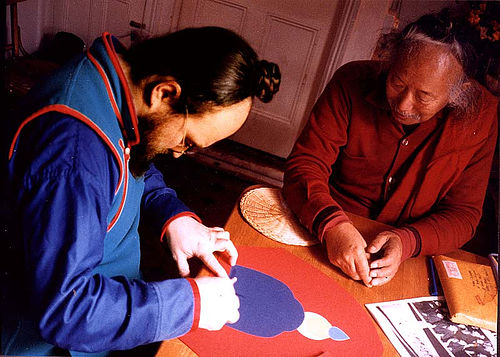
Dorje Chang Chhi’mèd Rig’dzin Rinpoche
Lineage Holder of the Chang gTér and Khordong gTér
Ngak’chang Rinpoche says of Chhi’mèd Rig’dzin Rinpoche:
He was one of the most important Nyingma Masters of the 20th century
who lived to see the first years of the current century. He was the holder of
two gTérma lineages: the Khordong gTér—which is the legacy of Nuden Dorje Dro’phang
Lingpa Tröllö Tsal—and the Chang gTér or Northern Treasure—which is the
legacy of Rig’dzin Go’dem. He was a Speech incarnation of Padmasambhava and an
incarnated descendant of Khyéchung Lotsa, one of the Twenty-five Siddhis of
Chhimphu.
His style of teaching, presentation, and transmission were unique and dramatic,
but not dramatic in the sense in which a teacher might deliberately set out to
portray such a quality. The drama of Chhi’mèd Rig’dzin Rinpoche’s vajra-persona
and the vajra-ambience of his presence were self-igniting and self-manifesting
purely in accordance with the nature of those who presented themselves. In his
perfect efficacy he was always unpredictably unpredictable. In many ways
Chhi’mèd Rig’dzin Rinpoche was culturally extraordinarily atypical.
He stood outside the Tibetan milieu in terms of cultural affect—being beyond
such formulations—but neither was he ‘Westernised’. He was simply outside the
realm of categorisation.
He was highly politically astute and aware, although he had no personal interest in political activity. He was apolitical as a Lama and had complete disregard for status or prestige. I possess precious few ‘formally robed’ photographs of Chhi’mèd Rig’dzin Rinpoche, because he usually wore his clothes until they fell apart and never travelled with anything elaborate. In the formal photographs I have, he mainly wore my robes (ed. such as the robe waistcoat shown here).
In 1988 we had to make an empowerment hat
together – because his had been left behind. Chhi’mèd Rig’dzin Rinpoche was
always more concerned with bringing texts with him than with bringing
ritual regalia – and our main activity together
consisted of translating texts – or for my part repairing texts which had been
partially eaten by silverfish. This was a difficult yet thoroughly enjoyable
activity because I often had to guess at what the words may have been behind the
holes in the paper – and that could often only be established in the context.
If I were ever utterly confounded by a hole in a particular text I would simply
show it to Chhi’mèd Rig’dzin Rinpoche and he would give me the missing word
without even looking up from the text he was
examining.
Ngak’chang Rinpoche and Chhi’mèd Rig’dzin Rinpoche worked for an entire morning on producing the card model of the Dorje Zahorma hat, and at one point Ngak’chang Rinpoche asked Chhi’mèd Rig’dzin Rinpoche if there was a name for this particular Dorje Zahorma hat – to which Chhi’mèd Rig’dzin Rinpoche replied: Hat CR Lama makes in Cardiff.
Ngak’chang Rinpoche comments:
What always amazed me about Chhi’mèd Rig’dzin Rinpoche was his consummate inventiveness. Many people feel inclined to invent new forms simply in order to impose themselves upon the tradition – but Chhi’mèd Rig’dzin Rinpoche only ever invented or originated things when there was need. We had no brocade available and the only coloured card available at the very moment we had to begin work was what was in my art draw. It was intriguing then that we later took samples of the card to the fabric shop in order to match them exactly to the card from which we had made the model for the hat. I asked Chhi’mèd Rig’dzin Rinpoche about this and why—as the coloured cards in my art draw were arbitrary in terms of hat making—he was so concerned to match them. Chhi’mèd Rig’dzin Rinpoche simply smiled and said: ‘There is a special reason.’ I never discovered what that reason was, as Chhi’mèd Rig’dzin Rinpoche’s visit was so full of activity and teachings that the moment slipped away.
